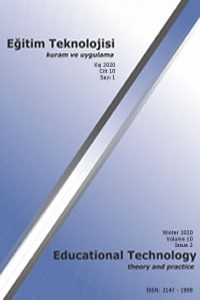Öz
Artırılmış gerçeklik teknolojileri zaman içerisinde donanım
ve yazılım yönünden gelişimini sürdürmektedir. Artırılmış gerçeklik
tarayıcıları mobil platformlar için geliştirilmiş bir artırılmış gerçeklik
yazılımıdır. Son yıllarda artırılmış gerçeklik tarayıcıları kullanımı artmakta
ve günlük kullanımı yaygınlaşmaktadır. Bu çalışmada artırılmış gerçeklik
tarayıcılarının (AGT) kullanımlarına yönelik kullanıcı görüşlerinin incelenmesi
amaçlanmıştır. Araştırma, nitel araştırma yöntemlerinden durum çalışması deseni
ile yürütülmüştür. Araştırma, 2017-2018 akademik yılı bahar döneminde
“Artırılmış Gerçeklik Ortam Tasarımı ve Analizi” dersine kayıtlanmış 7 lisans
öğrencisi ile gerçekleştirilmiştir.
Araştırma kapsamında kişisel bilgi formu, yarı yapılandırılmış odak
grubu görüşme formu ve açık uçlu sorulardan oluşan anket olmak üzere üç ayrı
veri toplama aracı kullanılmıştır. Verilerin analizinde içerik analiz yöntemi
kullanılmıştır. Bu süreçte kodlar düzenlenerek temalar araştırmanın soruları
doğrultusunda şekillenmiştir. Analizlerin gerçekleştirilmesinde ATLAS.ti 8
programından yararlanılmıştır. Araştırma sonuçları incelendiğinde AGT’lerin
sunduğu içerikler açısında ön planda olduğu, arayüz ve teknik anlamda ise
geliştirilmeleri gerektiği tespit edilmiştir. AGT’lerin özellikle konum tabanlı
tetikleme destekleri, canlandırma ve çözümleme gibi teknik yönleri üzerinde
çalışmalar yürütülmesi önerilmektedir.
Anahtar Kelimeler
Kaynakça
- Abdüsselam, M. S., & Güntepe, E. T. (2018). Augmented Reality: Educational Resources. Editör: Reyes Ruiz G. & Hernández Hernández M., In Augmented Reality for Enhanced Learning Environments (pp. 1-24). IGI Global.
- Abdüsselam, M.S. (2016). Artırılmış Gerçeklik Tarayıcıları. Editör İşman A., Odabaşı H.F., Akkoyunlu B., Eğitim Teknoloji Okumaları 2016, (pp.19-36) TOJET, AnkaraAugment (2019). AR Viewer. https://www.augment.com/blocks/ar-viewer/ adresinden 4 Haziran 2019 tarihinde alınmıştır.
- Blippar (2019). AR Agency. https://www.blippar.com/ar-studio adresinden 4 Haziran 2019 tarihinde alınmıştır.
- Dunser A., Grasset R., and Billinghurst M. (2008). A survey of evaluation techniques used in augmented reality studies. Human Interface Technology Laboratory New Zealand, In Proceedings ACM SIGGRAPH ASIA (pp. 1–27). New York, NY, USA.
- Grubert, J., Langlotz, T., & Grasset, R. (2011). Augmented reality browser survey. https://pdfs.semanticscholar.org/d592/91c3fc198a9b13dbbe72b11bd0ebaef40196.pdf adresinden 14 Nisan 2018 tarihinde alınmıştır.
- Herpich, F., Guarese, R. L. M., & Tarouco, L. M. R. (2017). A Comparative Analysis of Augmented Reality Frameworks Aimed at the Development of Educational Applications. Creative Education, 8(09), 1433-1451.
- HP Reveal (2019). Landing Page. https://studio.hpreveal.com/landing adresinden 4 Haziran 2019 tarihinde alınmıştır.
- Jackson T., Angermann F., Meier P. (2011) Survey of Use Cases for Mobile Augmented Reality Browsers. Handbook of Augmented Reality. Springer, New York, NYKhan, A., & Khusro, S. (2015). The rise of augmented reality browsers: Trends, challenges and opportunities. Pakistan Journal of Science, 67(3). 288-300
- Langlotz, T., Nguyen, T., Schmalstieg, D., & Grasset, R. (2014). Next-generation augmented reality browsers: rich, seamless, and adaptive. Proceedings of the IEEE, 102(2), 155-169.
- Layar (2019). All Features. https://www.layar.com/features/all-features/ adresinden 4 Haziran 2019 tarihinde alınmıştır.
- Madden, L. (2011). Professional augmented reality browsers for smartphones: programming for junaio, layar and wikitude. UK: John Wiley & Sons Ltd.
- Marneanu, I., Ebner, M., & Roessler, T. (2014). Evaluation of Augmented Reality Frameworks for Android Development. International Journal of Interactive Mobile Technologies (iJIM), 8(4), 37-44.
- McPherson, R., Jana, S., & Shmatikov, V. (2015, May). No escape from reality: Security and privacy of augmented reality browsers. In Proceedings of the 24th International Conference on World Wide Web (pp. 743-753). International World Wide Web Conferences Steering Committee.
- Miles, M. B. ve Huberman, A. M. (1994). Qualitative data analysis: An expanded sourcebook (2thed.). California: Sage.
- Paiva Guimarães, M., & Martins, V. F. (2014). A checklist to evaluate Augmented Reality Applications. In 2014 XVI Symposium on Virtual and Augmented Reality (pp. 45-52). IEEE.
- Pixlive (2019). Prodects Vidinoti. https://www.vidinoti.com/products/ adresinden 4 Haziran 2019 tarihinde alınmıştır.
- Pranoto, H., Tho, C., Warnars, H. L. H. S., Abdurachman, E., Gaol, F. L., & Soewito, B. (2017, November). Usability testing method in augmented reality application. In Information Management and Technology (ICIMTech), 2017 International Conference on (pp. 181-186). IEEE.
- Prensky, M. (2001). Digital natives, digital immigrants, On the Horizon, 9(5), 1-6.
- Reicher, T., Mac Williams, A., Brugge, B., & Klinker, G. (2003, October). Results of a study on software architectures for augmented reality systems. In The Second IEEE and ACM International Symposium on Mixed and Augmented Reality, 2003. Proceedings. (pp. 274-275). IEEE.
- Serino, M., Cordrey, K., McLaughlin, L., & Milanaik, R. L. (2016). Pokémon Go and augmented virtual reality games: a cautionary commentary for parents and pediatricians. Current opinion in pediatrics, 28(5), 673-677.
- Uluyol, Ç., & Şahin, S. (2016). Augmented reality: A new direction in education. Editör: Choi, D. H., Dailey-Hebert, A., & Estes, J. S.. In Emerging Tools and Applications of Virtual Reality in Education (pp. 239-257). IGI Global.
- Wikitude (2019). Wikitude Studio. https://www.wikitude.com/products/studio/ adresinden 4 Haziran 2019 tarihinde alınmıştır.
- Yıldırım A., Şimşek H (2013) Sosyal Bilimlerde Nitel Araştırma Yöntemleri, Ankara: Seçkin Yayın Evi.
Ayrıntılar
| Birincil Dil | Türkçe |
|---|---|
| Bölüm | Makaleler |
| Yazarlar | |
| Yayımlanma Tarihi | 31 Ocak 2020 |
| Yayımlandığı Sayı | Yıl 2020 Cilt: 10 Sayı: 1 |


